

Graph databases: an overview. In a previous article, we introduced a few concepts related to graphs, and illustrated them with two examples using the Neo4j graph database.

For the previous years, many companies have been developing graph databases — as software vendors like Neo Technology (Neo4j), Objectivity (InfiniteGraph), Sparsity (dex*), or by building their own custom solution to integrate it into their applications, like LinkedIn or Twitter. Thus it can be hard to grasp a global picture of this rich landscape in continuous evolution. In this new article focused on graph databases, we will give you the elements that are necessary to understand how they fit into the ecosystem, compared to the other kinds of databases and to the other types of graph processing tools. Boilerpipe - Boilerplate Removal and Fulltext Extraction from HTML pages. This project is moving to The following information is outdated and only provided for reference.
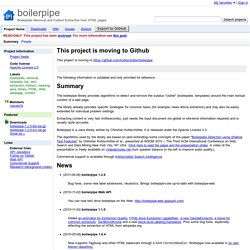
The boilerpipe library provides algorithms to detect and remove the surplus "clutter" (boilerplate, templates) around the main textual content of a web page. The library already provides specific strategies for common tasks (for example: news article extraction) and may also be easily extended for individual problem settings. Extracting content is very fast (milliseconds), just needs the input document (no global or site-level information required) and is usually quite accurate. Boilerpipe is a Java library written by Christian Kohlschütter.
The algorithms used by the library are based on (and extending) some concepts of the paper "Boilerplate Detection using Shallow Text Features" by Christian Kohlschütter et al., presented at WSDM 2010 -- The Third ACM International Conference on Web Search and Data Mining New York City, NY USA. AngularJS — Superheroic JavaScript MVW Framework. Java Language Support extension. Sign in to write a review Sort by:
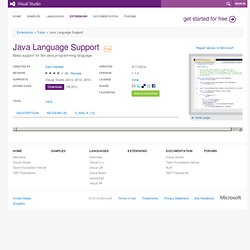
Compiling Java in Visual Studio. I often see my fellow comp. sci. students writing their (relatively) simple Java code in applications like Emacs, Nano or Eclipse.

I’m not fond of either application. I much prefer Visual Studios text handling, solution overview, output windows and so forth. What most people don’t know is that you can actually extend Visual Studio to a great extent. One way to extend Visual Studio is to write plugins using .NET, but there’s a way that is much simpler (albeit also more limited). I will now show how you can make Visual Studio compile and run your Java applications all within Visual Studio itself. First of all, you need to download and install the Java JDK. Create a new Visual Studio project. Start out by deleting the automatically created Class1.cs file. One of the really cool features of Visual Studio is that it actually includes Intellisense for a lot of the standard Java classes, so you’re not left totally on your own. Now comes the compilation part. Go to Tools -> External Tools… Creating a bot. Robots or bots are automatic processes that interact with Wikipedia (and other Wikimedia projects) as though they were human editors.
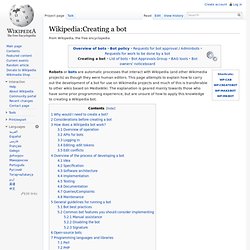
This page attempts to explain how to carry out the development of a bot for use on Wikimedia projects and much of this is transferable to other wikis based on MediaWiki. The explanation is geared mainly towards those who have some prior programming experience, but are unsure of how to apply this knowledge to creating a Wikipedia bot. Why would I need to create a bot? [edit] Bots can automate tasks and perform them much faster than humans. .net - Windows Service Facebook C# SDK Architecture.
My Movie API, Movie Data Web Service. Rewire the web. Autofac: Home. Dependency Injection with Autofac. Download source code - 139.27 KB Contents Introduction.

Buu Nguyen's Blog » The Legend of Data Persistence – Part 1. 1.
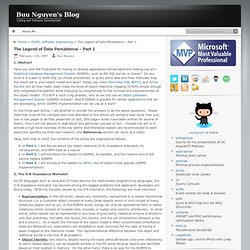
Abstract Have you ever felt frustrated for having to develop applications whose back-end making use of a Relational Database Management System (RDBMS), such as MS SQL Server, or Oracle? Do you think it is a pain to write SQL (or stored procedures) to query some data and then manually map the result set to your object model and back? Great, you have Hibernate, EJB, iBATIS, and Active Record, but do they really really make the work of object-relational mapping (O-R/M) simple enough and completely transparent while imposing no compromises to the richness and expressiveness of the object model? If O-R/M is such a big problem, why do we not use an Object Database Management System (ODBMS) instead? In this three-part article, I will attempt to provide the answers to all the above questions. Okay, with that in mind, the contents of the article are organized as follows: 2. 3. Blitz - Load and Performance Testing from the Cloud. How to write fluent interface with C# and Lambda.
Last week I had a nice discussion in the office about “how to write fluent interface” and I have found a couple of articles over the internet about that.
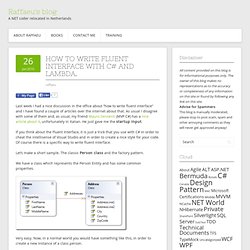
As usual I disagree with some of them and, as usual, my friend Mauro Servienti (MVP C#) has a nice article about it, unfortunately in Italian. He just gave me the startup input. ScraperWiki. Buu Nguyen's Blog » The Legend of Data Persistence – Part 2. In Part 1 of this article, I have discussed about the Object-Relational (O-R) impedance mismatch, the problem it causes as well as the pitfalls of some O-R/M tools.

In this part, I will examine Object Database Management System (ODBMS) and compare it with Relational Database Management System (RDBMS). 1. What is ODBMS Basically, an ODBMS is a DBMS which stores objects as opposed to rows or tuples in respectively a SQL or a RDBMS [Wikipedia, Object Database] and bornt out of the need for transparent and non-intrusive persistence of complex object model, tasks which could not easily be addressed by RDBMS because of the O-R impedance mismatch.
As a DBMS, besides being a data respository for storing object graphs (together with their identities, attributes, associations, and inheritance information), an ODBMS would, at the very least, include a query engine, a concurrency management system, and a data recovery mechanism. Standardization 2. A. B. 3.
A. B. Welcome to Eloquera. BrightstarDB - NoSQL for .NET. BrightstarDB - NoSQL for .NET.